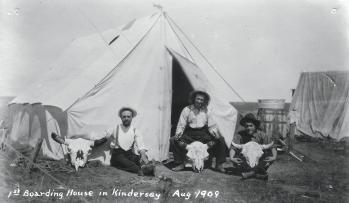

Town, pop 4,548, located in the province’s west-central region, between Rosetown and the Saskatchewan-Alberta border at the junction of Hwys 7 and 21. The first settlers began arriving in the district in 1907. The townsite was surveyed in September 1909 and on January 10, 1910, the village of Kindersley was incorporated; it was named after Sir Robert Kindersley, a major shareholder in the Canadian Northern Railway. Ten months later, Kindersley attained town status. The community, whose fortunes depended on grain farming, had a population of just over 1,000 by the early 1920s. In the early 1950s, major discoveries of oil and gas in the region ushered in an era of rapid development and a surge in Kindersley’s population, which soared from 990 in 1941 to 1,755 in 1951, then to 2,990 in 1961. Today, agriculture and the oil and gas industry continue to form the basis of the economy. Kindersley is the main shopping, service, and administrative centre for a trading area population of approximately 40,000 people; strategically located on the main highway between Saskatoon and Calgary, it has an annual traffic count of over 5 million vehicles. Area attractions include the Addison Sod House and the Great Wall of Saskatchewan. Built between 1909 and 1911, the Addison house is the oldest continuously inhabited sod building in the province; and the “Great Wall”—a kilometre long, three metres wide, two metres high—was built over 30 years by Albert “Stonewall” Johnson entirely of stones and without the use of cement or mortar, for purely aesthetic purposes.
David McLennan